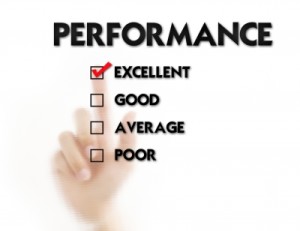 Everyone hates them,
Everyone hates them,
No one refers to them,
They are out of date soon after writing them,
So why waste everyone’s time?
Performance Appraisals. Those dreaded forms that managers hate filling out and employees dread going over, page by page. Most don’t judge real performance, with standard categories and numerical rating scales that have little to do with real jobs. What happens? To meet HR’s deadline, managers rush through to get them done—just to have something to hand in before the deadline. Or they get shoved behind real emergencies or year-end budgets or financials or any other excuse for not getting them done. Or, they are written and delivered late or not at all. So who cares? Why bother?
Employees care. They want to know how they are doing, especially what they are doing right. Believe it or not, employees want to have that personal, one-on-one meeting with their manager. This is an employee’s opportunity to get her manager’s attention, have a conversation, get some feedback, a little praise and appreciation, and maybe even make a pitch for a raise.
Managers should care. How are they going to coach and develop employees, improve performance and productivity if employees never hear what they are doing well and what needs improvement? No one likes to give negative feedback, but a performance appraisal is the one time of year that a manager has the green light to lay it out. After all, this is the performance review. Permission granted to point out failings and suggest changes and set goals. No awkward called meetings and uncomfortable conversations to discuss problems or mistakes on the fly. No, this is the time and place.
So how can managers and employees make this a not so dreadful annual exercise that will actually have some meaning? How can employees get real performance feedback based on their particular job requirements? What better way than to use the employee’s job description. (Well, that is if you have one that actually resembles the job the employee is doing.) And that’s where real, valuable, customized, authentic performance feedback starts. So ditch the standardized forms, the 1 to 5 numeric rating scale and the block narratives that take so much time. No need to write a new customized form. Just take the job description, put “Annual Performance Review (year)” at the top, and use the bullet points for discussion and a simple “Meets” or “Exceeds” notation after each. The real value isn’t the rating, it’s the conversation.
What about the “does not meet” rating? Is that really necessary? Duh, if an employee doesn’t get one of the first two, draw the obvious conclusion. Rather than just make a negative judgement, focus on what has to happen to rate a “meets” or “Exceeds” at the next review. Bullet points that go unrated need improvement. No need to label them. Those bullet points become the goals set for the next review period. Some can wait until next year. Some may need a closer look sooner than that. A custom job description review calls for a customized follow-up plan.
Using the job description for a performance review is the perfect time for an update, since jobs morph over time, expand and contract. Job descriptions are rarely revised over the year. Instead of taking time to revise job descriptions as a separate exercise, make that part of the review process. Two birds with one stone, as they say. For some managers, this exercise will be a revelation, since managers may not know what their employees really do every day. Employees get a blow-by-blow review of their job responsibilities; managers get a real life, revised job description to hold an employee accountable for the next year.
Jobs are getting more complicated. If the last recession taught business anything, it was how to get the same amount of work (or more) from fewer people. Technology has expanded the workday, whether we admit it (or like it) or not. We’re working longer, harder, and with less real communication despite instant communications, in a variety of forms, in the palm of our hands. Simplified performance feedback is an essential tool to appreciate, value and redirect employee effort to increase job satisfaction and productivity. Keep it simple. Who has time for complicated?

Leave a Reply
You must be logged in to post a comment.